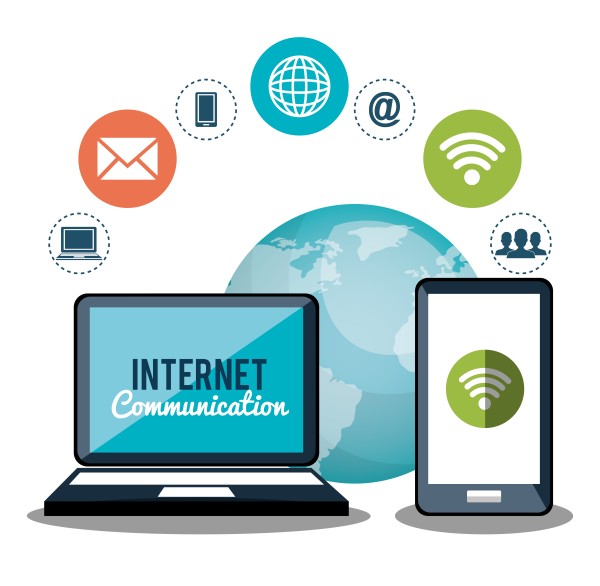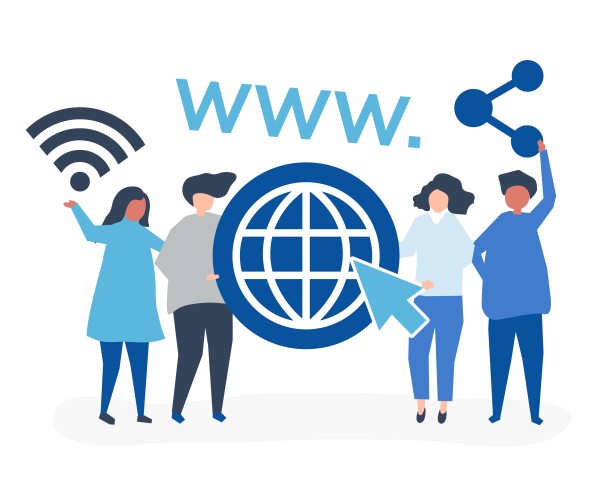Communication and commerce have transformed during the digital era. Many activities, such as opening a browser or sending a message, happen within seconds. The Internet powers these connections by moving data at remarkable speed. Yet the underlying process can appear mysterious.
Here in this article, we will discuss how exactly do internet works and also outlines why distributed networking matters, how the physical infrastructure enables data flow, and how these ideas link to websites and applications. Finally, it describes what “building a better Internet” entails in practical terms
What is the Internet?
The Internet is a global system of interconnected computer networks that share data through TCP/IP protocols. Each device that joins this system receives a unique IP address, which guides data to the intended destination.
When a device sends a request, packets of information travel across networks and routers until reaching the correct server. That server replies with the requested data, which arrives as a series of packets. The requesting device then reassembles the data, displaying it as text, images, or other formats.
Researchers in the 1960s began exploring ways to link computers over long distances. Those experiments laid the groundwork for a framework that eventually became today’s Internet.
Over time, more institutions and businesses connected, forming a vast, decentralized network. The adoption of email and the World Wide Web accelerated growth, producing a hub for learning, commerce, and entertainment.

Key Principles of Distributed Networking
Distributed networking spreads data across multiple nodes or devices. This design approach does not rely on a single central server to handle traffic. Instead, routers and switches share the responsibility of directing data to the right place.
- Reliability: Outages in one part of the network do not halt the entire system. Traffic can take alternative paths.
- Scalability: Adding servers and devices expands the network without straining a single control point.
- Redundancy: Backup routes keep data moving if any component encounters issues.
Distributed networking practices evolved from research that aimed to protect data routes from disruption. The design also supports collaboration.
Various entities can interconnect and exchange packets across shared protocols. That open structure has allowed the Internet to handle massive traffic, such as streaming platforms and large-scale conferences.
How Does the Internet Work?

- Packet-Based Transmission: Any piece of information sent across the Internet first breaks into smaller chunks called packets. Each packet carries both the sender’s and the receiver’s IP addresses, along with data that indicates sequence and error-checking details. Routers read this addressing information and forward each packet step by step toward the destination. Transmission Control Protocol (TCP) manages re-sending any lost or damaged packets, and Internet Protocol (IP) ensures each packet’s address is correct.
- Domain Name System (DNS): Domain names like example.com exist because numeric IP addresses can be inconvenient to remember. DNS servers store the mappings of domain names to IP addresses. When a browser needs to locate example.com, the DNS system returns the corresponding IP address. This lookup involves local resolvers, which can check cached records, and higher-level DNS servers, including root and TLD servers.
- Routing Decisions: Routers keep routing tables that guide each data packet to the next hop. Protocols like BGP (Border Gateway Protocol) enable routers to share updates about reachable networks. If an outage or slowdown arises, traffic can shift routes. The distributed nature of routing fosters stability. Multiple routes mean fewer single points of failure.
- Assembly at the Destination: Packets can arrive in any order, depending on network conditions. TCP reassembles them in the correct sequence and verifies completeness. Once the data reassembles, the browser, app, or service displays the requested content.
Critical Physical Infrastructure
- Fiber Optic Cables: Fiber optic lines move data using pulses of light through glass or plastic strands. These cables can handle large amounts of data over long distances. Urban hubs often rely on fiber backbones to connect local networks to regional ones. Businesses, service providers, and governments typically invest in these networks for reliable, high-speed transmission.
- Satellite Connections: Some regions lack roads or structures to support long cable runs. Satellites fill that gap, sending data via radio waves between ground stations and orbiting satellites. Though satellite links can introduce extra latency due to the distances involved, newer technologies improve speed and responsiveness. Emergencies or distant areas often benefit most from this setup.
- Cellular Networks: Smartphones and tablets rely on mobile networks that use radio signals to move data. Towers link these signals to the broader Internet, routing packets between a device and remote servers. Advancements in cellular technology have increased data transfer speeds, allowing tasks like high-definition streaming.
- Undersea Cables: Vast cables rest on or beneath the ocean floor, carrying signals across continents. These cables form the backbone for international data exchange. Specialized ships lay these cables, and repairs can be costly. Multiple protective layers shield the cables from fishing gear, anchors, and environmental threats.
- Data Centers: Data centers house servers that store websites, applications, and databases. These buildings require cooling, power backups, and robust security. Servers inside data centers respond to incoming requests by sending relevant data. Clusters of routers and switches in each facility connect the internal server racks to external networks. The data is then routed to users around the globe.
Link to Websites and Applications
Websites and apps operate on top of these physical and logical foundations. A browser sends HTTP or HTTPS requests to a server’s IP address.
Those requests pass through local routers, travel across the ISP, then hop across various networks before arriving at the hosting server. The server processes the request, pulls information from databases if needed, and sends the response back in data packets.
- Hosting and CDNs: Website owners pay for hosting solutions or rent server space in data centers. Many also use Content Delivery Networks (CDNs) that cache static resources like images and scripts on distributed servers located in different regions. CDNs reduce loading times by delivering data from servers closer to requesters, cutting down on physical distance and overall latency.
- APIs: Applications frequently access remote services through Application Programming Interfaces (APIs). An app that tracks weather or handles online shopping might query an API for updated information, passing data and receiving a structured response. That exchange also depends on TCP/IP and follows the same steps of packet transmission and routing.
- Security: Encryption is widespread due to concerns over malicious interception of data. HTTPS protects data traveling between a browser and a web server by scrambling (encrypting) the content. Only the sender and the receiver hold the keys needed to interpret it. Firewalls filter out suspicious traffic, while intrusion detection systems watch for patterns that suggest hacking attempts.
Building a Better Internet
Efforts to improve the Internet take many forms. Some focus on expanding coverage to rural or underserved communities.
Others concentrate on strengthening the encryption and security measures that guard sensitive information. Various initiatives and open-source projects also seek to refine protocols for faster, more efficient data flow.
These efforts can involve:
- Network Upgrades: Businesses and governments invest in new fiber lines, satellite technologies, or improved cellular systems. More bandwidth can reduce congestion and speed data transfers. Regular maintenance of existing infrastructure also plays a large role.
- Balancing Privacy and Control: User data protection remains a pressing concern. Some regions legislate strict privacy regulations, requiring greater transparency on how data is shared. Advocates of net neutrality strive to keep all traffic treated equally, preventing service providers from blocking or slowing specific sites or applications.
- Future Innovations: IPv6 adoption continues to rise, solving the IPv4 address shortage by allowing a vastly larger address pool. Edge computing relocates data processing closer to end users, reducing latency. Artificial intelligence helps optimize routing by detecting overloads and redirecting traffic. Quantum networking research aims to enable super-secure communication based on quantum cryptography.
Addressing Network Congestion and Security Hurdles
Surges in data flow can cause slowdowns or outages. ISPs, private firms, and public institutions collaborate to alleviate these bottlenecks by distributing loads.
Content Delivery Networks route streams or large downloads across multiple servers, spreading out the impact during peak hours. Various caching mechanisms and load balancers help keep performance steady.
Security threats also challenge the concept of a better Internet. Attackers target networks to steal data, disrupt services, or demand ransom. Some groups share threat intelligence to detect suspicious patterns early.
Others develop authentication methods, such as multi-factor verification, to make unauthorized access more difficult. Coordinated global efforts exist to block malicious domains and shut down large-scale hacking campaigns.
Sample Use Cases of Distributed Architecture
- Online Education: Students in different regions watch lectures from servers located closer to their locale, resulting in lower latency. If a node in one region fails, traffic reroutes through another path.
- Financial Transactions: Banking platforms ensure reliable service by hosting servers in multiple data centers. If one data center encounters downtime, requests continue at an alternate location.
- Real-Time Communication: Voice and video calls operate through a steady stream of packets. Distributed routing ensures minimal disruption if a single link experiences congestion.
- Social Platforms: Billions of users interact across a vast array of servers. Even during usage spikes, the system keeps functioning due to redundant routing and local caching.
Practical Pointers for Maintaining Reliable Connectivity
- Choose an ISP that invests in strong networks and has stable peering arrangements.
- Activate encryption (HTTPS or TLS) for every site that handles sensitive data.
- Inspect local networking gear, such as cables and switches, for failures.
- Use load testing to ensure servers can handle peaks in traffic.
- Consider CDNs or edge servers to serve large media files near end users.
Ensuring Continued Evolution
Groups and volunteer bodies work together to maintain and upgrade the protocols that make up the Internet. The Internet Engineering Task Force (IETF) publishes RFCs (Requests for Comments) describing new or improved standards.
Collaboration among engineers, academics, and public bodies helps keep the system open. This method of shared oversight has prevented a single authority from dominating Internet design.
Academic labs often test cutting-edge ideas like quantum data channels or specialized routing methods. Enterprises refine networking equipment to handle bigger loads or improve speeds.
Public institutions invest in infrastructure to close digital gaps between urban centers and rural districts. This collective approach results in a network that adapts to changing demands and remains responsive to future growth.
Conclusion
The Internet runs on a vast web of cables, satellites, routers, and protocols. Packets of data circulate along routes defined by distributed networking, providing resilience and scalability.
DNS maps domain names to IP addresses, making it simple to reach websites. Encryption and security measures keep sensitive data safe. In data centers, servers store the content that browsers and apps access daily. Undersea cables link continents, ensuring that global communication can continue at all hours.
In practical terms, this network of networks supports commerce, communication, healthcare, and entertainment. Distributed principles ensure that when one segment faces problems, alternative routes remain open.
Ongoing work to make the Internet faster, more secure, and more widespread reflects the collective effort to enhance digital life. That vision includes bridging divides in access, strengthening encryption, and adopting new protocols. Each improvement paves the way for the next stage in global connectivity and digital innovation.
Also Read:
